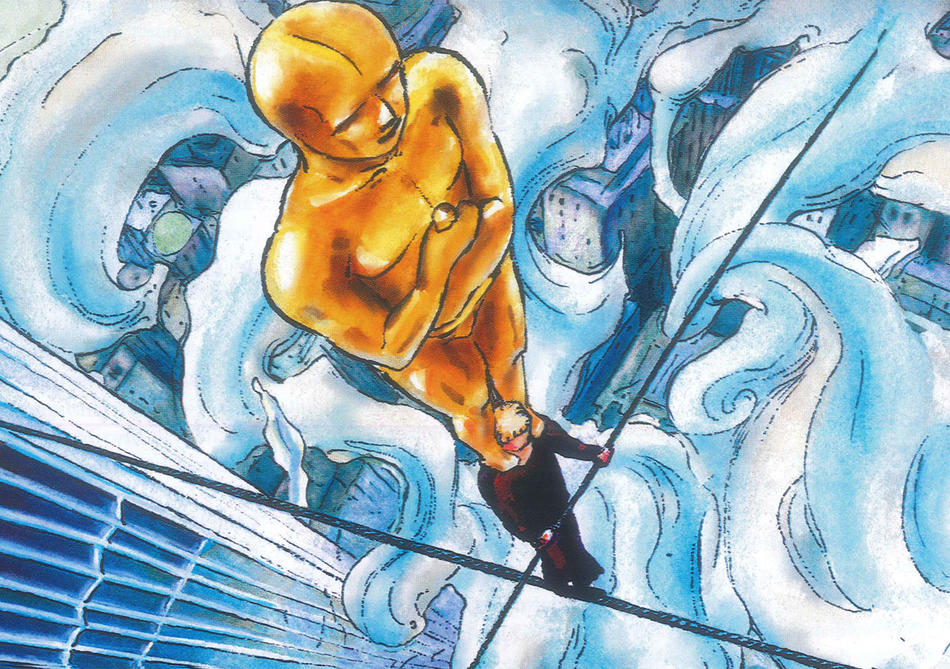In 1979, a monument in honor of William J. “Wild Bill” Donovan 1905CC, 1908LAW was unveiled on the plaza outside the Law School. The bronze sculpture, by the Dutch artist Kees Verkade, depicts a tightrope walker supporting another figure on his shoulders as he traverses a length of cable. Verkade wanted to convey the valor and “controlled daring” of Donovan, a much-decorated battalion leader in the Great War who was appointed in 1941 by his Columbia law classmate Franklin Delano Roosevelt to head what would become the Office of Strategic Services, the forerunner of the modern Central Intelligence Agency.
Tightrope walkers had a certain currency in 1979. A year earlier, the most famous high-wire artist in the world, Karl Wallenda, patriarch of the daredevil circus troupe the Flying Wallendas, fell to his death during a walk between the towers of a hotel in San Juan, Puerto Rico. And in August 1974, a young French street performer named Philippe Petit shocked the world by staging the ultimate piece of guerrilla theater: he and his cohorts sneaked into the World Trade Center and ingeniously rigged, between the rooftops of the Twin Towers, a slender steel cable, 200 feet of it, upon which Petit frolicked and genuflected for 45 minutes, a quarter of a mile in the sky.
Bill Donovan would have found much to admire in Petit, whose own formidable acts of espionage, subterfuge, intelligence gathering, planning, and derring-do are portrayed in the documentary Man on Wire, directed by British filmmaker James Marsh and coproduced by Maureen Ryan ’92SOA. Praise for the movie, which is Marsh and Ryan’s fifth collaboration, has been unanimous — literally. The movie review aggregator Rottentomatoes.com reports that all 137 reviews for Man on Wire have been favorable, making it that Web site’s top-ranked film. After winning both the Grand Jury Prize for Documentary and the Audience Award at Sundance in 2008, Man on Wire snagged Best Documentary from the New York Film Critics Circle, the Los Angeles Film Critics Association, and the Boston Society of Film Critics, among others. This February, to no one’s surprise, it won the Academy Award for Best Documentary Feature.
Ryan, who has been teaching production in the film department since 1999, first knew that she was involved in something special when the crew went to Petit’s home in Upstate New York to interview him. “Philippe is so energetic and full of life and has this vision of the world that is so invigorating,” Ryan says. “And to find that he was such an amazing, captivating storyteller — that was a telltale sign. So it was like, ‘Let’s not screw this up. Let’s build on that and move forward.’ Which we did.”
With each interview of Petit’s band of conspirators, Ryan’s sense of the thing grew, but what sealed it for her was the beautifully shot archival footage of the long-haired schemers, who looked as if they’d stepped out of an early Yes album, as they rehearsed for the soon-to-be-completed World Trade Center on a makeshift wire in a lush green field in France. “At that point I just thought, ‘OK. We’re operating on all cylinders here.’”
A measure of luck is integral to any work of art, and just as Petit managed to assemble a motley, erratic, but ultimately successful gang of adventurers to help him realize his dream of dancing between the towers, he also entrusted his incredible story — along with breathtaking footage of his earlier illegal wire-walking escapades in Paris and Sydney — to exactly the right team of filmmakers. Perhaps the best thing that can be said about Man on Wire is that it is equal to its subject. The result is a movie of unusual emotional impact, in which awestruck audiences have been known to gasp and weep as they are confronted with nothing less than the beauty of art — but art on a scale that is superhuman: prodigious in its risks, sublime in its form, thrilling in its sheer defiance, radical in its implication. “Inspiring” is the word that Ryan most often hears from moviegoers.
It all starts with Petit, a merry provocateur possessed of all the charm, wit, poetry, confidence, cunning, and persuasiveness of a born cult leader. But Ryan knows as well as anyone that Petit’s accomplishment that August morning 35 years ago was hardly the work of a single, obsessed visionary.
“His accomplices are just as interesting,” she says. “They were a group of people coming together for one vision and making it happen: for me, as a producer, that’s what we do when we make a film. I really relate to that and what they were able to do. I think it was a miracle.”
The miracle is made all the more poignant, of course, by the eventual demise of the buildings; the grainy record of the towers’ construction — the giant pit, the cranes hoisting the familiar latticed steel panels, the shirtless hardhats swarming like worker ants over the skeleton of the colossus — brings us obscurely into the realm of myth, of Daedalus and Icarus, architecture and soaring ambition, creation and destruction. The movie makes no reference to September 11, an artistic choice that proves the axiom that what’s left out is as important as what’s put in. This absence gives the audience the psychic space to process, as Ryan says, “the need and desire to reclaim those towers for ourselves, to replace those images that we’ve seen so many times and to be able to take them back and remember the beginning.”
Watching Man on Wire, one gains an appreciation for the notion of “controlled daring” that the sculptor Verkade attributes to Bill Donovan. And though Philippe Petit may never have a statue of a wire walker built for him on the grounds of Columbia, the community still has the opportunity to see the real thing: Petit is artist-in-residence at the Cathedral of St. John the Divine, which was rededicated this past December after a 2001 fire that had severely damaged the building. As part of the celebration, Petit walked across a rope that was tied to a pillar and held taut about five feet off the ground on the other end by several spectators. Death-defying? No. Life-affirming? Certainement.
And as for Maureen Ryan? Her statue needs have been fulfilled, at least for now.
“I was 12 years old and I saw the Academy Awards for the first time,” she says, “and I thought to myself, ‘Someday I want to be there.’ It really was my dream.”



